Comprehensive Risk Management Plan for Shell Australia's Operations
VerifiedAdded on 2023/01/18
|14
|2704
|98
Report
AI Summary
This report presents a comprehensive risk management plan specifically tailored for Shell Australia, a prominent fuel company. It begins by establishing the context and scope of the plan, focusing on key operational areas such as distribution, equipment, and processes. The core of the report involves the identification of critical risks, including operational discontinuities (oil spills), accidents, innovation challenges, and environmental impact issues. Each risk is then subjected to a detailed analysis, assessing its severity, potential impact areas, and resulting consequences. The report proceeds to outline and document specific risk management treatments, detailing actions, resource allocation, responsible personnel, timelines, and expected outcomes for each identified risk. This is followed by an examination of monitoring and evaluation processes, including success criteria and methods like audits and operational efficiency assessments, to ensure the plan's effectiveness. The report concludes by emphasizing the importance of a proactive risk management approach for Shell Australia's long-term sustainability and stakeholder protection.

RISK
MANAGEMENT
MANAGEMENT
Paraphrase This Document
Need a fresh take? Get an instant paraphrase of this document with our AI Paraphraser
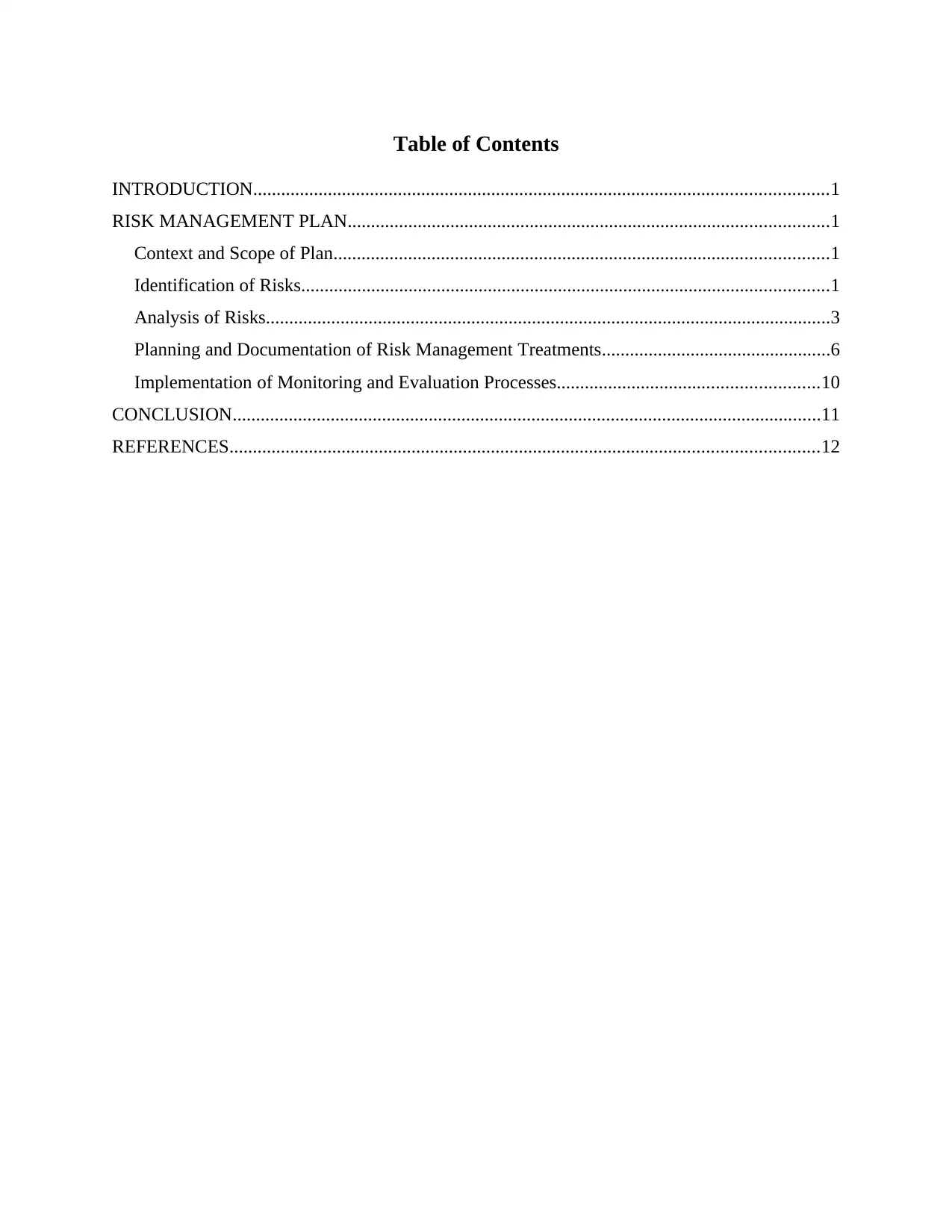
Table of Contents
INTRODUCTION...........................................................................................................................1
RISK MANAGEMENT PLAN.......................................................................................................1
Context and Scope of Plan..........................................................................................................1
Identification of Risks.................................................................................................................1
Analysis of Risks.........................................................................................................................3
Planning and Documentation of Risk Management Treatments.................................................6
Implementation of Monitoring and Evaluation Processes........................................................10
CONCLUSION..............................................................................................................................11
REFERENCES..............................................................................................................................12
INTRODUCTION...........................................................................................................................1
RISK MANAGEMENT PLAN.......................................................................................................1
Context and Scope of Plan..........................................................................................................1
Identification of Risks.................................................................................................................1
Analysis of Risks.........................................................................................................................3
Planning and Documentation of Risk Management Treatments.................................................6
Implementation of Monitoring and Evaluation Processes........................................................10
CONCLUSION..............................................................................................................................11
REFERENCES..............................................................................................................................12

INTRODUCTION
Risk Management is an appropriate area of practice which is associated with ensuring
management of several types of risks, which could cause certain fatalities and disadvantages to
the companies. Furthermore, it is very crucial for the firm to control the same in order to assure
consistent working and safety of the employees as well as the people (Cruden, 2017). In relation
to this, the report below is based on risk assessment and management within Shell Australia,
which is one of the most recognised fuel companies within the country and globally. Hence, the
report covers the probable risk areas associated with the company, along with its effective
analysis, contingency planning and monitoring.
RISK MANAGEMENT PLAN
Context and Scope of Plan
The very first aspect which is required to be undertaken by the company in relation to its
risk management plan is related to determining the scope upon which the plan would be
implemented. This would allow in analysing the applicability of the plan on different
departments and functions of the organisation.
Shell Australia is the subsidiary of Royal Dutch Shell, which is associated with dealing in
storage and distribution terminals, oil refineries, and service stations for transportations and
storage of oils. Moreover, it also operates in exploration of oil, coal and petrochemical mining.
However, there are several areas where the plan would be implemented within the company. One
such area is its distribution function, as it has been prone to several risks related to transport
inefficiencies. Furthermore, another aspect is associated with the operations of the firm, which is
related to risks associated with inefficiencies of equipments and processes, as well as certain
practices. Hence, the scope of the plan would be quite wide as it would be covering prominent
areas of functioning within the company that are necessary to be able to perform at their highest
efficiencies.
Identification of Risks
This step within the risk management plan is related to identification of several risk areas
that is required by the company to look into in relation to identify the consequences of these
risks, departments they might affect and extent to which they are severe.
Operational Discontinuity:
1
Risk Management is an appropriate area of practice which is associated with ensuring
management of several types of risks, which could cause certain fatalities and disadvantages to
the companies. Furthermore, it is very crucial for the firm to control the same in order to assure
consistent working and safety of the employees as well as the people (Cruden, 2017). In relation
to this, the report below is based on risk assessment and management within Shell Australia,
which is one of the most recognised fuel companies within the country and globally. Hence, the
report covers the probable risk areas associated with the company, along with its effective
analysis, contingency planning and monitoring.
RISK MANAGEMENT PLAN
Context and Scope of Plan
The very first aspect which is required to be undertaken by the company in relation to its
risk management plan is related to determining the scope upon which the plan would be
implemented. This would allow in analysing the applicability of the plan on different
departments and functions of the organisation.
Shell Australia is the subsidiary of Royal Dutch Shell, which is associated with dealing in
storage and distribution terminals, oil refineries, and service stations for transportations and
storage of oils. Moreover, it also operates in exploration of oil, coal and petrochemical mining.
However, there are several areas where the plan would be implemented within the company. One
such area is its distribution function, as it has been prone to several risks related to transport
inefficiencies. Furthermore, another aspect is associated with the operations of the firm, which is
related to risks associated with inefficiencies of equipments and processes, as well as certain
practices. Hence, the scope of the plan would be quite wide as it would be covering prominent
areas of functioning within the company that are necessary to be able to perform at their highest
efficiencies.
Identification of Risks
This step within the risk management plan is related to identification of several risk areas
that is required by the company to look into in relation to identify the consequences of these
risks, departments they might affect and extent to which they are severe.
Operational Discontinuity:
1
⊘ This is a preview!⊘
Do you want full access?
Subscribe today to unlock all pages.

Trusted by 1+ million students worldwide
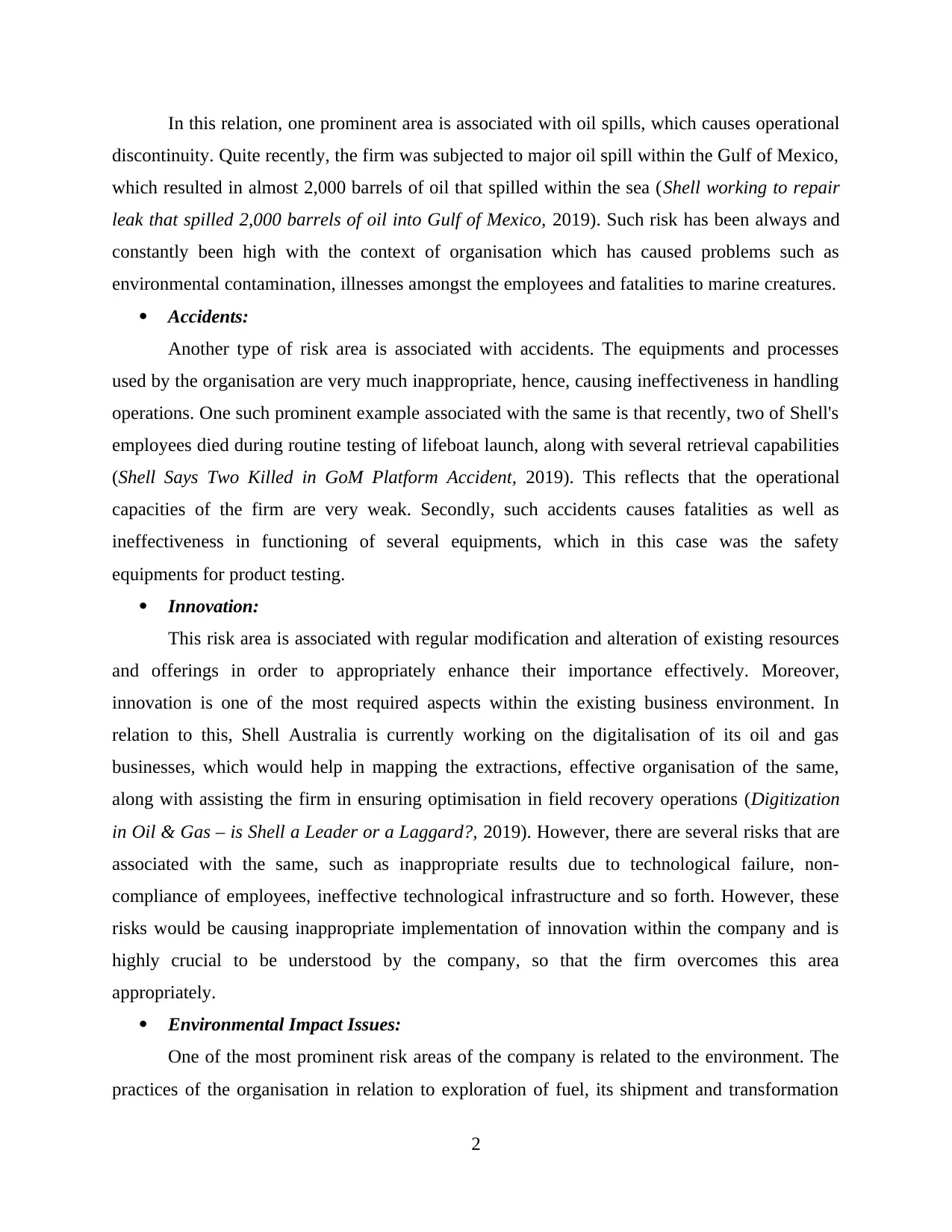
In this relation, one prominent area is associated with oil spills, which causes operational
discontinuity. Quite recently, the firm was subjected to major oil spill within the Gulf of Mexico,
which resulted in almost 2,000 barrels of oil that spilled within the sea (Shell working to repair
leak that spilled 2,000 barrels of oil into Gulf of Mexico, 2019). Such risk has been always and
constantly been high with the context of organisation which has caused problems such as
environmental contamination, illnesses amongst the employees and fatalities to marine creatures.
Accidents:
Another type of risk area is associated with accidents. The equipments and processes
used by the organisation are very much inappropriate, hence, causing ineffectiveness in handling
operations. One such prominent example associated with the same is that recently, two of Shell's
employees died during routine testing of lifeboat launch, along with several retrieval capabilities
(Shell Says Two Killed in GoM Platform Accident, 2019). This reflects that the operational
capacities of the firm are very weak. Secondly, such accidents causes fatalities as well as
ineffectiveness in functioning of several equipments, which in this case was the safety
equipments for product testing.
Innovation:
This risk area is associated with regular modification and alteration of existing resources
and offerings in order to appropriately enhance their importance effectively. Moreover,
innovation is one of the most required aspects within the existing business environment. In
relation to this, Shell Australia is currently working on the digitalisation of its oil and gas
businesses, which would help in mapping the extractions, effective organisation of the same,
along with assisting the firm in ensuring optimisation in field recovery operations (Digitization
in Oil & Gas – is Shell a Leader or a Laggard?, 2019). However, there are several risks that are
associated with the same, such as inappropriate results due to technological failure, non-
compliance of employees, ineffective technological infrastructure and so forth. However, these
risks would be causing inappropriate implementation of innovation within the company and is
highly crucial to be understood by the company, so that the firm overcomes this area
appropriately.
Environmental Impact Issues:
One of the most prominent risk areas of the company is related to the environment. The
practices of the organisation in relation to exploration of fuel, its shipment and transformation
2
discontinuity. Quite recently, the firm was subjected to major oil spill within the Gulf of Mexico,
which resulted in almost 2,000 barrels of oil that spilled within the sea (Shell working to repair
leak that spilled 2,000 barrels of oil into Gulf of Mexico, 2019). Such risk has been always and
constantly been high with the context of organisation which has caused problems such as
environmental contamination, illnesses amongst the employees and fatalities to marine creatures.
Accidents:
Another type of risk area is associated with accidents. The equipments and processes
used by the organisation are very much inappropriate, hence, causing ineffectiveness in handling
operations. One such prominent example associated with the same is that recently, two of Shell's
employees died during routine testing of lifeboat launch, along with several retrieval capabilities
(Shell Says Two Killed in GoM Platform Accident, 2019). This reflects that the operational
capacities of the firm are very weak. Secondly, such accidents causes fatalities as well as
ineffectiveness in functioning of several equipments, which in this case was the safety
equipments for product testing.
Innovation:
This risk area is associated with regular modification and alteration of existing resources
and offerings in order to appropriately enhance their importance effectively. Moreover,
innovation is one of the most required aspects within the existing business environment. In
relation to this, Shell Australia is currently working on the digitalisation of its oil and gas
businesses, which would help in mapping the extractions, effective organisation of the same,
along with assisting the firm in ensuring optimisation in field recovery operations (Digitization
in Oil & Gas – is Shell a Leader or a Laggard?, 2019). However, there are several risks that are
associated with the same, such as inappropriate results due to technological failure, non-
compliance of employees, ineffective technological infrastructure and so forth. However, these
risks would be causing inappropriate implementation of innovation within the company and is
highly crucial to be understood by the company, so that the firm overcomes this area
appropriately.
Environmental Impact Issues:
One of the most prominent risk areas of the company is related to the environment. The
practices of the organisation in relation to exploration of fuel, its shipment and transformation
2
Paraphrase This Document
Need a fresh take? Get an instant paraphrase of this document with our AI Paraphraser

and refineries are very much inappropriate as per the perspective of environment. The reason for
this is that such extraction and distribution of fuels to the customers ultimately leads to depletion
of environment and reduction of fossil fuels. Hence, the risks associated with the same is related
to management and resource use. As reflected above, the firm is yet to enhance the management
practices within the company to analyse the inefficiencies and improving the same to ensure that
only prominent quantity of fuel is used and none of them goes to waste. Moreover, as per
resource use, the company is heavily relied on human resources and are not using technological
ones quite appropriately.
Analysis of Risks
It is quite crucial that the risks identified above are analysed in terms of determining the
extent of their severity, the areas which these risks could likely implement and consequences that
would be derived from the risks identified above. Hence, below is an appropriate mapping of
these risks which would allow a proper and effective display related to analysis of these factors:
RISK SEVERITY PERSON
RESPONSIBLE CAUSES CONSEQUENCES AREAS
AFFECTED
Accidents HIGH Managers Equipment
Failure
One of the major
consequences of
this risk is that it
could cause loss
of life within the
company.
Furthermore,
such accidents
could also cause
loss of trust of
employees,
community and
government from
the company.
Hence, the
Overall
Organisation
3
this is that such extraction and distribution of fuels to the customers ultimately leads to depletion
of environment and reduction of fossil fuels. Hence, the risks associated with the same is related
to management and resource use. As reflected above, the firm is yet to enhance the management
practices within the company to analyse the inefficiencies and improving the same to ensure that
only prominent quantity of fuel is used and none of them goes to waste. Moreover, as per
resource use, the company is heavily relied on human resources and are not using technological
ones quite appropriately.
Analysis of Risks
It is quite crucial that the risks identified above are analysed in terms of determining the
extent of their severity, the areas which these risks could likely implement and consequences that
would be derived from the risks identified above. Hence, below is an appropriate mapping of
these risks which would allow a proper and effective display related to analysis of these factors:
RISK SEVERITY PERSON
RESPONSIBLE CAUSES CONSEQUENCES AREAS
AFFECTED
Accidents HIGH Managers Equipment
Failure
One of the major
consequences of
this risk is that it
could cause loss
of life within the
company.
Furthermore,
such accidents
could also cause
loss of trust of
employees,
community and
government from
the company.
Hence, the
Overall
Organisation
3
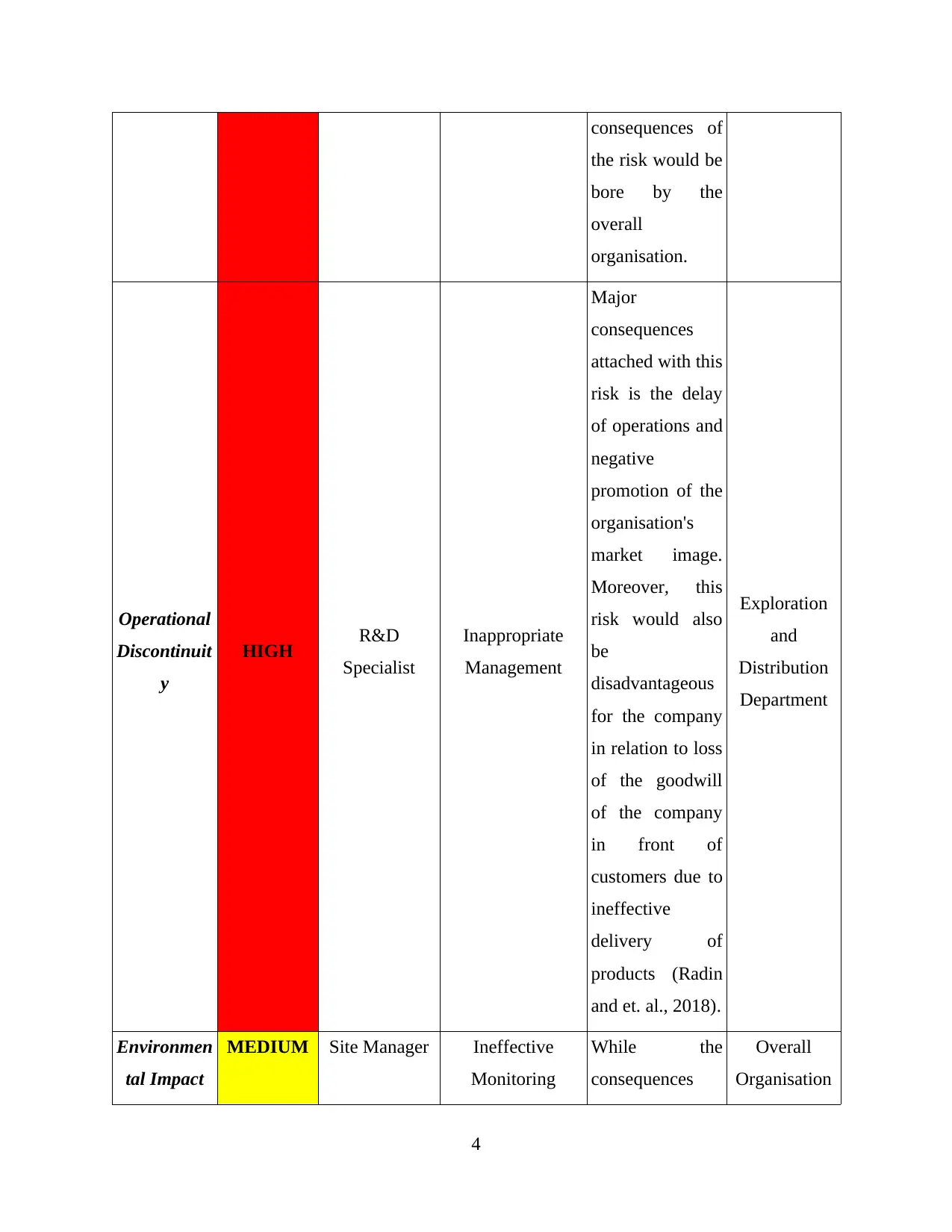
consequences of
the risk would be
bore by the
overall
organisation.
Operational
Discontinuit
y
HIGH R&D
Specialist
Inappropriate
Management
Major
consequences
attached with this
risk is the delay
of operations and
negative
promotion of the
organisation's
market image.
Moreover, this
risk would also
be
disadvantageous
for the company
in relation to loss
of the goodwill
of the company
in front of
customers due to
ineffective
delivery of
products (Radin
and et. al., 2018).
Exploration
and
Distribution
Department
Environmen
tal Impact
MEDIUM Site Manager Ineffective
Monitoring
While the
consequences
Overall
Organisation
4
the risk would be
bore by the
overall
organisation.
Operational
Discontinuit
y
HIGH R&D
Specialist
Inappropriate
Management
Major
consequences
attached with this
risk is the delay
of operations and
negative
promotion of the
organisation's
market image.
Moreover, this
risk would also
be
disadvantageous
for the company
in relation to loss
of the goodwill
of the company
in front of
customers due to
ineffective
delivery of
products (Radin
and et. al., 2018).
Exploration
and
Distribution
Department
Environmen
tal Impact
MEDIUM Site Manager Ineffective
Monitoring
While the
consequences
Overall
Organisation
4
⊘ This is a preview!⊘
Do you want full access?
Subscribe today to unlock all pages.

Trusted by 1+ million students worldwide
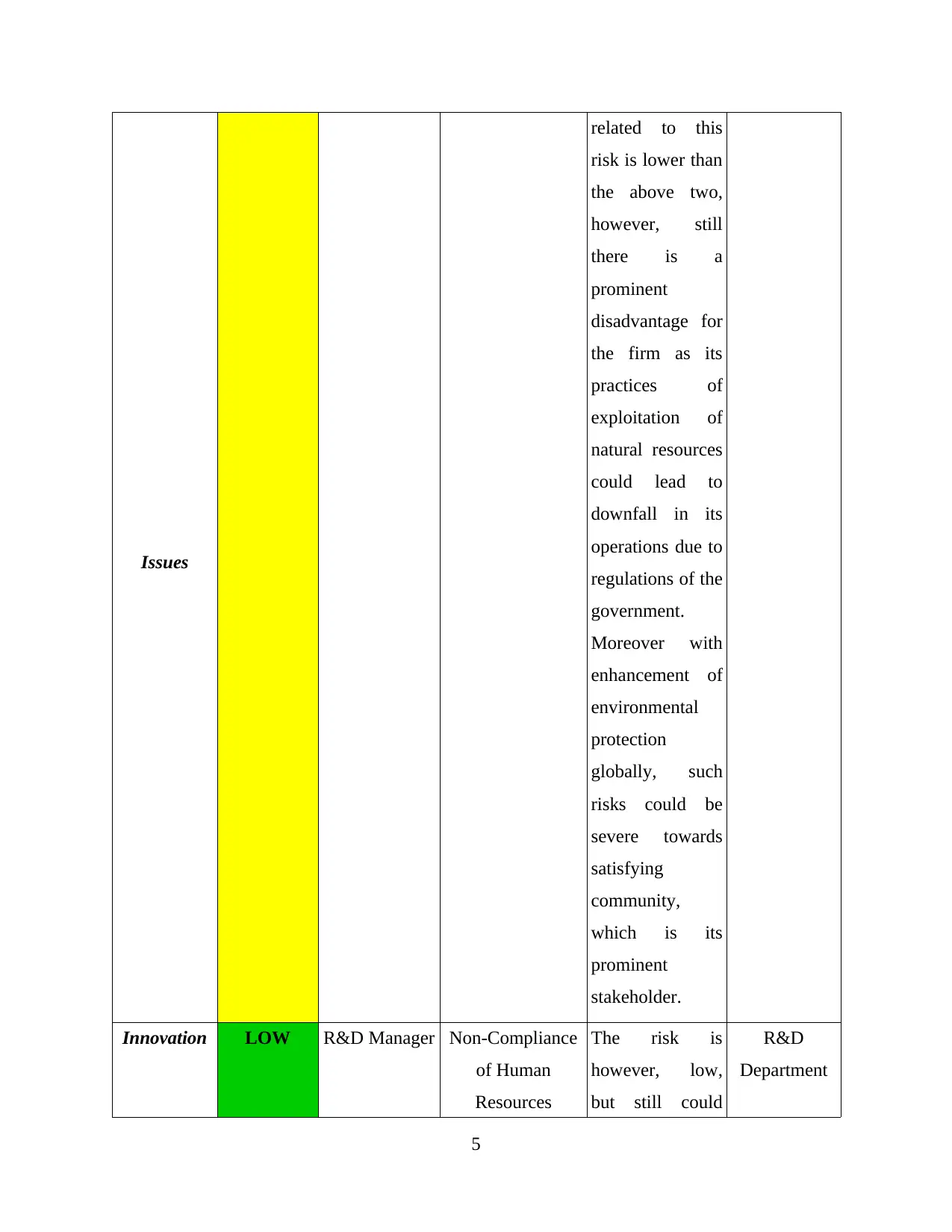
Issues
related to this
risk is lower than
the above two,
however, still
there is a
prominent
disadvantage for
the firm as its
practices of
exploitation of
natural resources
could lead to
downfall in its
operations due to
regulations of the
government.
Moreover with
enhancement of
environmental
protection
globally, such
risks could be
severe towards
satisfying
community,
which is its
prominent
stakeholder.
Innovation LOW R&D Manager Non-Compliance
of Human
Resources
The risk is
however, low,
but still could
R&D
Department
5
related to this
risk is lower than
the above two,
however, still
there is a
prominent
disadvantage for
the firm as its
practices of
exploitation of
natural resources
could lead to
downfall in its
operations due to
regulations of the
government.
Moreover with
enhancement of
environmental
protection
globally, such
risks could be
severe towards
satisfying
community,
which is its
prominent
stakeholder.
Innovation LOW R&D Manager Non-Compliance
of Human
Resources
The risk is
however, low,
but still could
R&D
Department
5
Paraphrase This Document
Need a fresh take? Get an instant paraphrase of this document with our AI Paraphraser
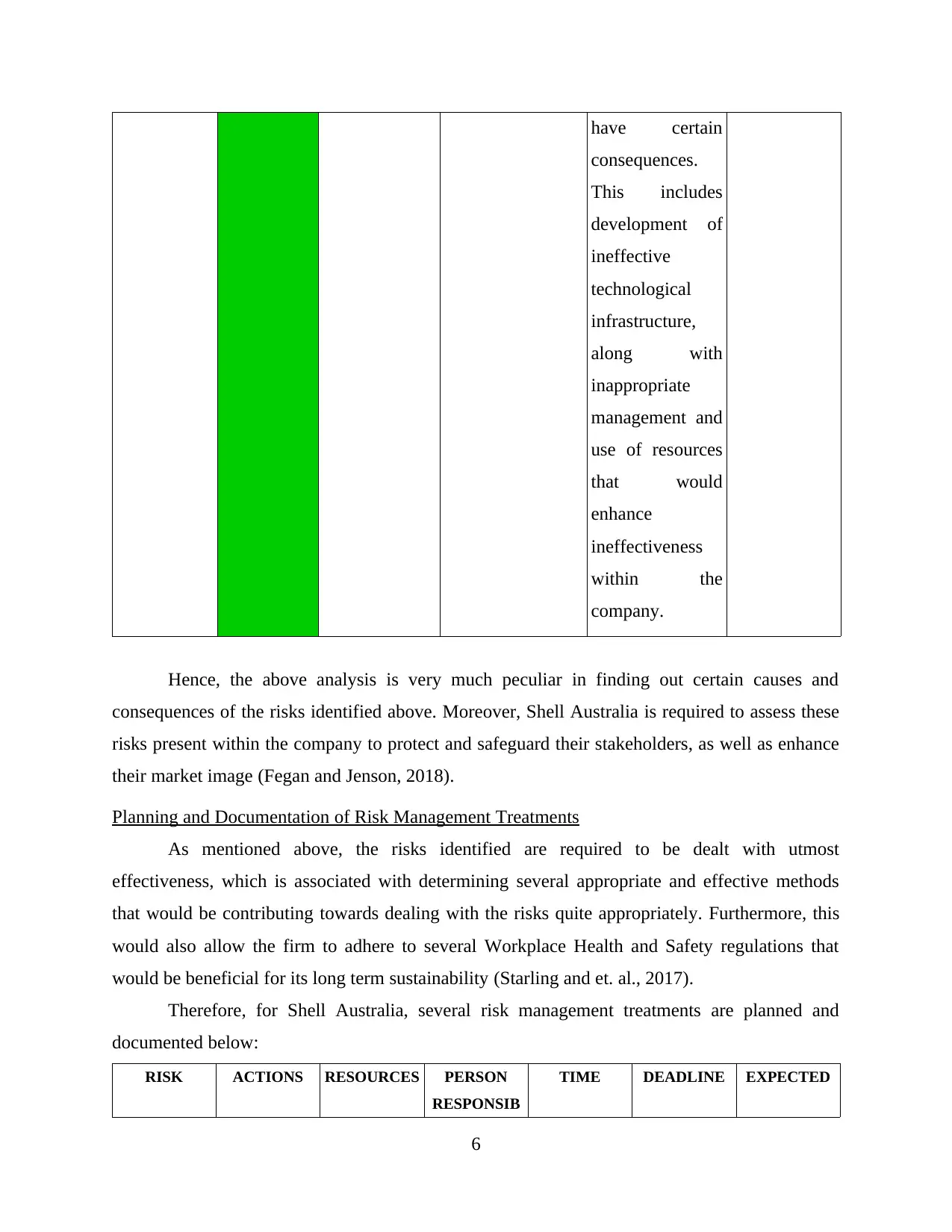
have certain
consequences.
This includes
development of
ineffective
technological
infrastructure,
along with
inappropriate
management and
use of resources
that would
enhance
ineffectiveness
within the
company.
Hence, the above analysis is very much peculiar in finding out certain causes and
consequences of the risks identified above. Moreover, Shell Australia is required to assess these
risks present within the company to protect and safeguard their stakeholders, as well as enhance
their market image (Fegan and Jenson, 2018).
Planning and Documentation of Risk Management Treatments
As mentioned above, the risks identified are required to be dealt with utmost
effectiveness, which is associated with determining several appropriate and effective methods
that would be contributing towards dealing with the risks quite appropriately. Furthermore, this
would also allow the firm to adhere to several Workplace Health and Safety regulations that
would be beneficial for its long term sustainability (Starling and et. al., 2017).
Therefore, for Shell Australia, several risk management treatments are planned and
documented below:
RISK ACTIONS RESOURCES PERSON
RESPONSIB
TIME DEADLINE EXPECTED
6
consequences.
This includes
development of
ineffective
technological
infrastructure,
along with
inappropriate
management and
use of resources
that would
enhance
ineffectiveness
within the
company.
Hence, the above analysis is very much peculiar in finding out certain causes and
consequences of the risks identified above. Moreover, Shell Australia is required to assess these
risks present within the company to protect and safeguard their stakeholders, as well as enhance
their market image (Fegan and Jenson, 2018).
Planning and Documentation of Risk Management Treatments
As mentioned above, the risks identified are required to be dealt with utmost
effectiveness, which is associated with determining several appropriate and effective methods
that would be contributing towards dealing with the risks quite appropriately. Furthermore, this
would also allow the firm to adhere to several Workplace Health and Safety regulations that
would be beneficial for its long term sustainability (Starling and et. al., 2017).
Therefore, for Shell Australia, several risk management treatments are planned and
documented below:
RISK ACTIONS RESOURCES PERSON
RESPONSIB
TIME DEADLINE EXPECTED
6

LE OUTCOME
Accidents
One of the
prominent
aspects in
relation to
deal with
this risk is
high end
product and
equipment
testing,
which
would allow
the firm to
ensure that
each
equipment
employed
within the
firm is as
per the
safety
requirement
s to support
its
operations
effectively
(Aerts and
et. al.,
2018).
Product
testing
technologies
such as
Artificial
Intelligence
and
Automation
would be
required to
ensure
effective
testing.
Managers 2 Months 3 Months
The most
expected
outcome of
the same is
in related to
reduction in
in accidents
and
fatalities
within the
company
and
promotion
of effective
practices.
7
Accidents
One of the
prominent
aspects in
relation to
deal with
this risk is
high end
product and
equipment
testing,
which
would allow
the firm to
ensure that
each
equipment
employed
within the
firm is as
per the
safety
requirement
s to support
its
operations
effectively
(Aerts and
et. al.,
2018).
Product
testing
technologies
such as
Artificial
Intelligence
and
Automation
would be
required to
ensure
effective
testing.
Managers 2 Months 3 Months
The most
expected
outcome of
the same is
in related to
reduction in
in accidents
and
fatalities
within the
company
and
promotion
of effective
practices.
7
⊘ This is a preview!⊘
Do you want full access?
Subscribe today to unlock all pages.

Trusted by 1+ million students worldwide
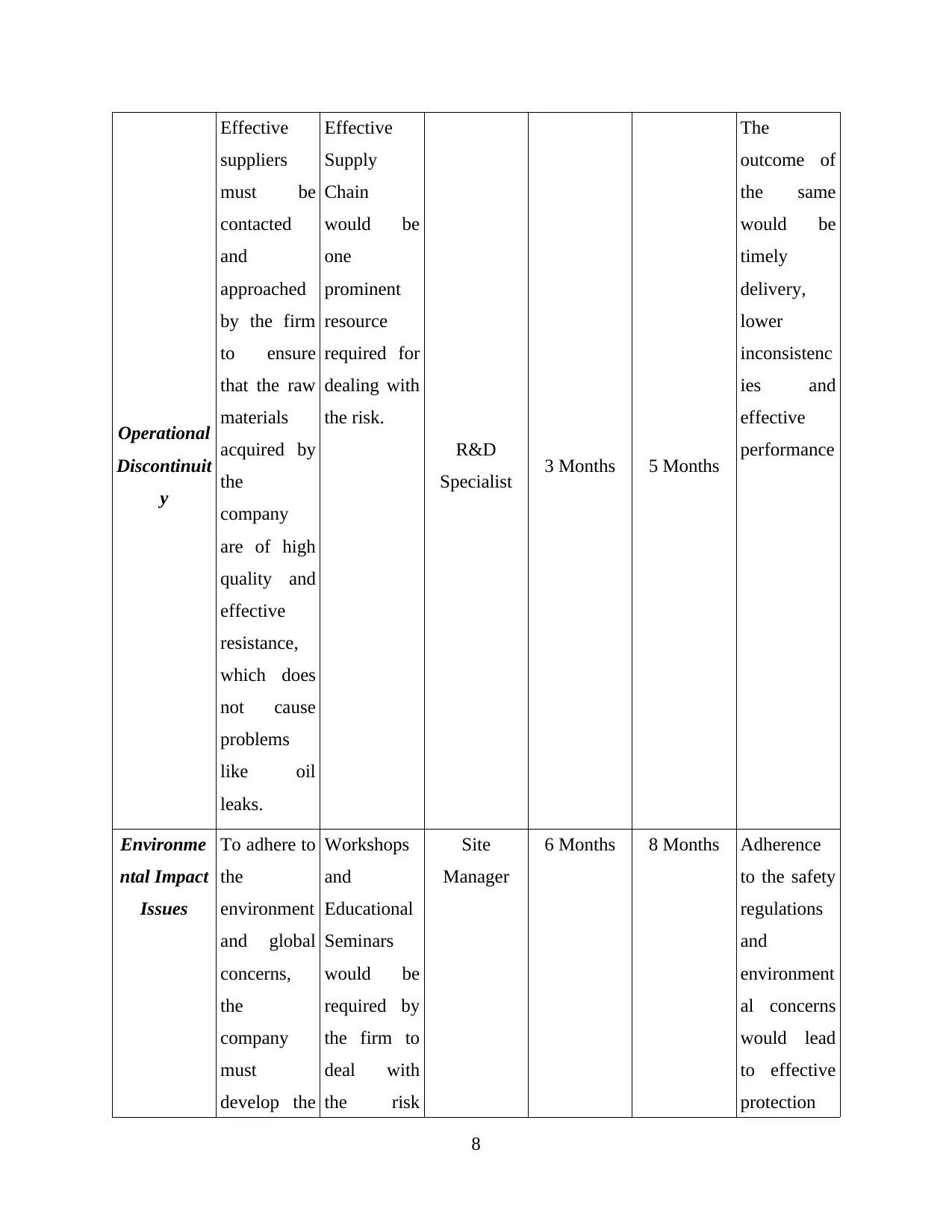
Operational
Discontinuit
y
Effective
suppliers
must be
contacted
and
approached
by the firm
to ensure
that the raw
materials
acquired by
the
company
are of high
quality and
effective
resistance,
which does
not cause
problems
like oil
leaks.
Effective
Supply
Chain
would be
one
prominent
resource
required for
dealing with
the risk.
R&D
Specialist 3 Months 5 Months
The
outcome of
the same
would be
timely
delivery,
lower
inconsistenc
ies and
effective
performance
Environme
ntal Impact
Issues
To adhere to
the
environment
and global
concerns,
the
company
must
develop the
Workshops
and
Educational
Seminars
would be
required by
the firm to
deal with
the risk
Site
Manager
6 Months 8 Months Adherence
to the safety
regulations
and
environment
al concerns
would lead
to effective
protection
8
Discontinuit
y
Effective
suppliers
must be
contacted
and
approached
by the firm
to ensure
that the raw
materials
acquired by
the
company
are of high
quality and
effective
resistance,
which does
not cause
problems
like oil
leaks.
Effective
Supply
Chain
would be
one
prominent
resource
required for
dealing with
the risk.
R&D
Specialist 3 Months 5 Months
The
outcome of
the same
would be
timely
delivery,
lower
inconsistenc
ies and
effective
performance
Environme
ntal Impact
Issues
To adhere to
the
environment
and global
concerns,
the
company
must
develop the
Workshops
and
Educational
Seminars
would be
required by
the firm to
deal with
the risk
Site
Manager
6 Months 8 Months Adherence
to the safety
regulations
and
environment
al concerns
would lead
to effective
protection
8
Paraphrase This Document
Need a fresh take? Get an instant paraphrase of this document with our AI Paraphraser
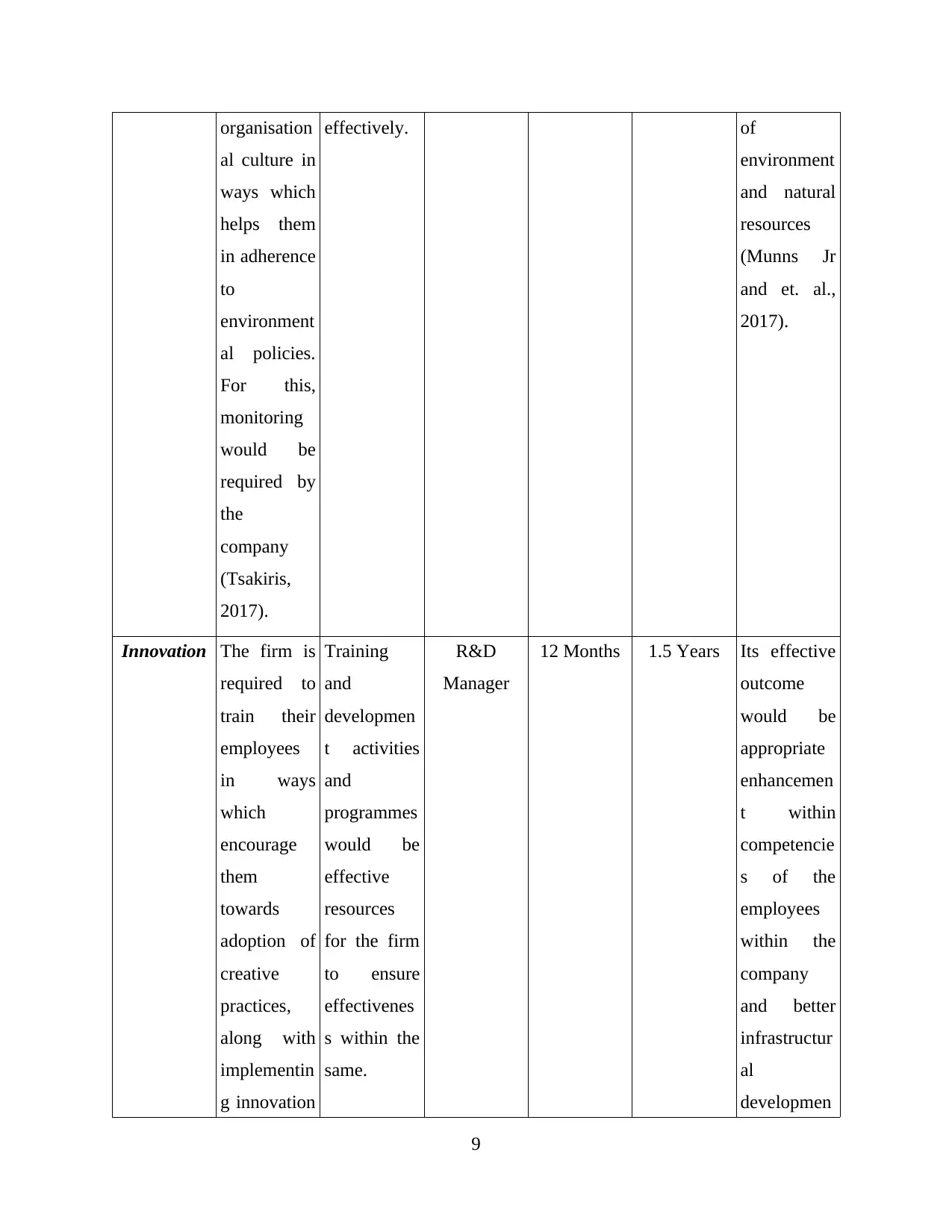
organisation
al culture in
ways which
helps them
in adherence
to
environment
al policies.
For this,
monitoring
would be
required by
the
company
(Tsakiris,
2017).
effectively. of
environment
and natural
resources
(Munns Jr
and et. al.,
2017).
Innovation The firm is
required to
train their
employees
in ways
which
encourage
them
towards
adoption of
creative
practices,
along with
implementin
g innovation
Training
and
developmen
t activities
and
programmes
would be
effective
resources
for the firm
to ensure
effectivenes
s within the
same.
R&D
Manager
12 Months 1.5 Years Its effective
outcome
would be
appropriate
enhancemen
t within
competencie
s of the
employees
within the
company
and better
infrastructur
al
developmen
9
al culture in
ways which
helps them
in adherence
to
environment
al policies.
For this,
monitoring
would be
required by
the
company
(Tsakiris,
2017).
effectively. of
environment
and natural
resources
(Munns Jr
and et. al.,
2017).
Innovation The firm is
required to
train their
employees
in ways
which
encourage
them
towards
adoption of
creative
practices,
along with
implementin
g innovation
Training
and
developmen
t activities
and
programmes
would be
effective
resources
for the firm
to ensure
effectivenes
s within the
same.
R&D
Manager
12 Months 1.5 Years Its effective
outcome
would be
appropriate
enhancemen
t within
competencie
s of the
employees
within the
company
and better
infrastructur
al
developmen
9

within the
firm's
structure.
t.
Implementation of Monitoring and Evaluation Processes
This is the last step within which the firm implements several monitoring and evaluating
practices associated with the risks above (Dalezios, 2017). Furthermore, the company is also
required to determine the success criteria of the above risks. Hence, this criteria is mentioned
below: Lower rate of Accidents: The success criteria of the risks associated with the accidents is
related to the reduction in its rate, which would be beneficial for the organisation. Enhanced Performance: Success criteria of risk related to operational discontinuity is
associated with higher consistency and performance of resources of the firm particularly
within the distribution and storage areas (Lyu and et. al., 2019). Environmental Protection: The success criteria in relation to issues related to
environment would be the adherence of people towards the laws and regulations of the
firm's and government policies.
High Competence: Innovation must be implemented without any risk for higher benefits
and hence, the success criteria in this context is related to high competence of employees
in adapting and working towards innovation.
Apart from the above analysis, the monitoring and evaluation processes of the firm
includes the following: Audits: One of the most appropriate monitoring methods of risks related to accidents and
operational discontinuity is Audits. This would allow appropriate testing and checking
that each and every process, equipment and strategy within the company are safe and
effective enough for driving the performance of the firm.
Operational Efficiencies: In relation to innovation and Environmental impact risks, one
of the way through which the firm could ensure effectiveness in these areas is related to
monitoring and tapping its operational efficiencies associated with these aspects through
10
firm's
structure.
t.
Implementation of Monitoring and Evaluation Processes
This is the last step within which the firm implements several monitoring and evaluating
practices associated with the risks above (Dalezios, 2017). Furthermore, the company is also
required to determine the success criteria of the above risks. Hence, this criteria is mentioned
below: Lower rate of Accidents: The success criteria of the risks associated with the accidents is
related to the reduction in its rate, which would be beneficial for the organisation. Enhanced Performance: Success criteria of risk related to operational discontinuity is
associated with higher consistency and performance of resources of the firm particularly
within the distribution and storage areas (Lyu and et. al., 2019). Environmental Protection: The success criteria in relation to issues related to
environment would be the adherence of people towards the laws and regulations of the
firm's and government policies.
High Competence: Innovation must be implemented without any risk for higher benefits
and hence, the success criteria in this context is related to high competence of employees
in adapting and working towards innovation.
Apart from the above analysis, the monitoring and evaluation processes of the firm
includes the following: Audits: One of the most appropriate monitoring methods of risks related to accidents and
operational discontinuity is Audits. This would allow appropriate testing and checking
that each and every process, equipment and strategy within the company are safe and
effective enough for driving the performance of the firm.
Operational Efficiencies: In relation to innovation and Environmental impact risks, one
of the way through which the firm could ensure effectiveness in these areas is related to
monitoring and tapping its operational efficiencies associated with these aspects through
10
⊘ This is a preview!⊘
Do you want full access?
Subscribe today to unlock all pages.

Trusted by 1+ million students worldwide
1 out of 14
Related Documents
Your All-in-One AI-Powered Toolkit for Academic Success.
+13062052269
info@desklib.com
Available 24*7 on WhatsApp / Email
![[object Object]](/_next/static/media/star-bottom.7253800d.svg)
Unlock your academic potential
Copyright © 2020–2025 A2Z Services. All Rights Reserved. Developed and managed by ZUCOL.





